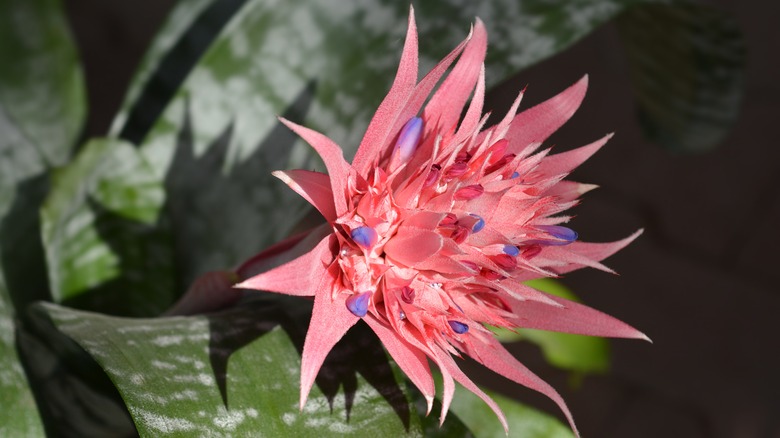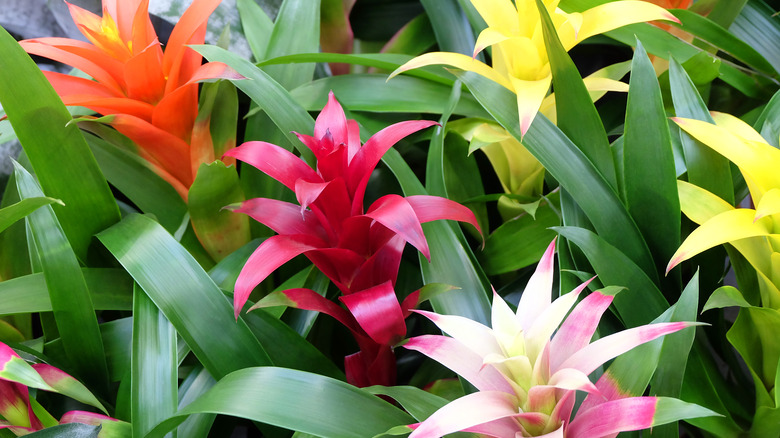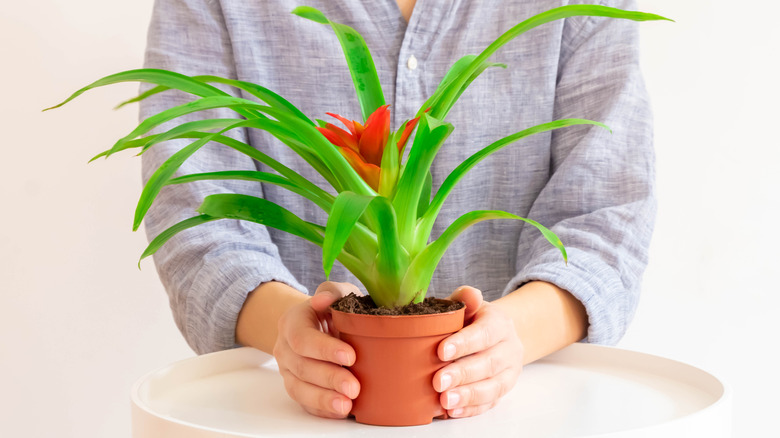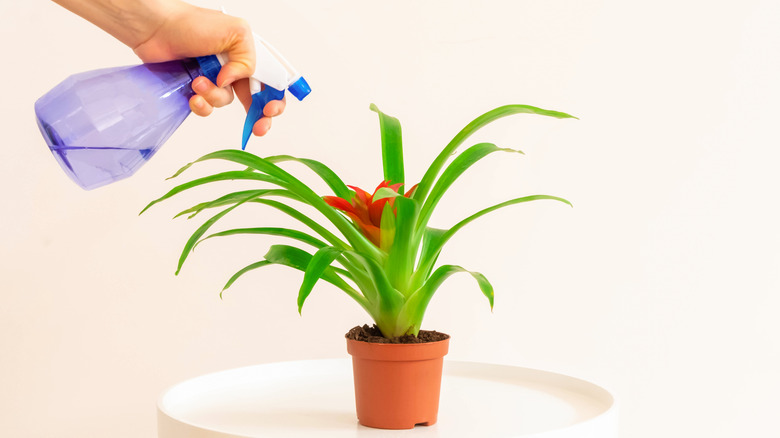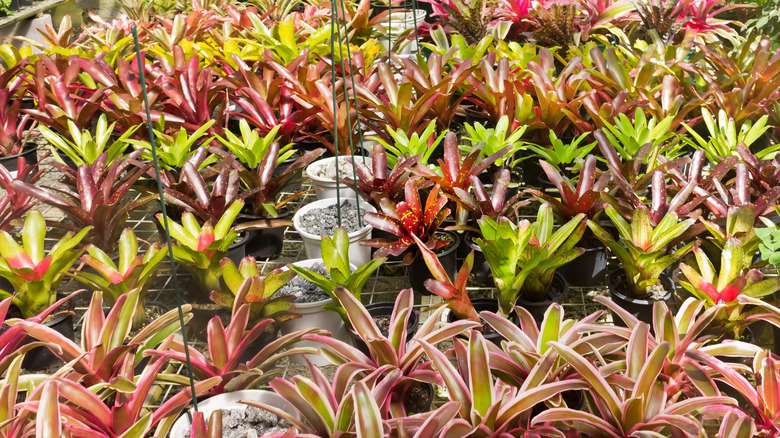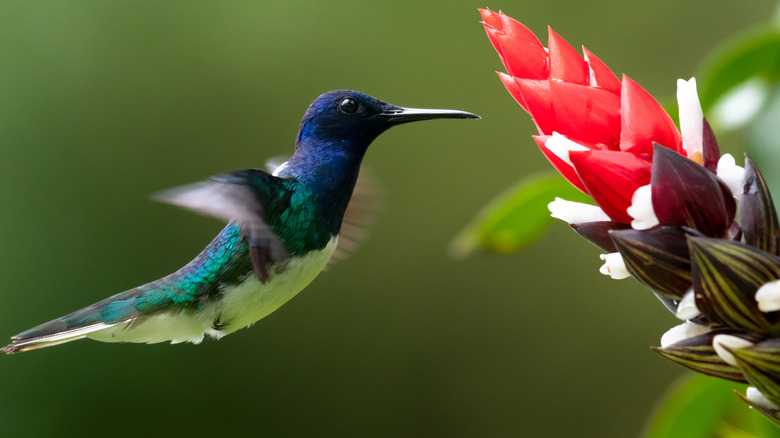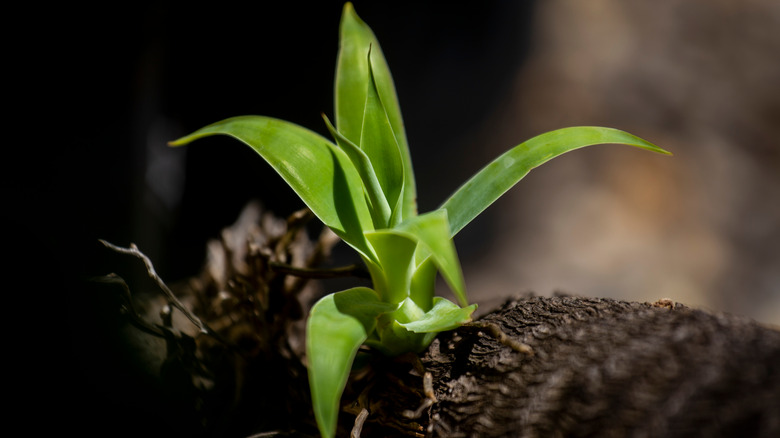How To Take Care Of Deroose Plants
The Deroose plant is named for the man who widely popularized and distributed the plant better-known as the bromeliad, according to Tampa Bay Times. Both terms refer to a diverse plant family that comprises over 2500 species. While that number may seem overwhelming, bromeliads.info assures readers that most species follow similar rules of care. Most species are native to tropical climates, but Deroose plants are hardy and thrive in a variety of climatic conditions in deserts, rainforests, and even mountains. Also known as a type of "air plant," in the wild they grow without soil, instead, attaching themselves to tree branches.
Bromeliads can be grown both indoors in a container, or outdoors to add charm to your garden. Wherever you decide to grow them, they will attract plenty of attention thanks to their exotic appearance, and thick and beautiful foliage. Their colorful leaves appear in shades of orange, purple, green, red, and yellow, occasionally even mistaken for flowers. Read on to find out more about this stunning, yet easy-to-maintain plant.
How to use Deroose plants in garden
Deroose plants are beautifully eye-catching, immediately commanding attention. While they can be grown outdoors in your garden, they may be better showcased if arranged in pots in your garden or landscaping scheme. Low-growing varieties are appropriate for planting along sidewalks or at the edge of your flower garden. Their sprawling foliage also makes them a good choice for uniquely colorful groundcover, if you plant several together.
Gardenista suggests that Deroose plants look exceptionally striking when you have several planted in repetition. Because they typically are low-growing, it is a good idea to pair them beside taller plants that can also provide some cover from direct sunlight, for instance, palm trees. You can also get a few epiphytic or "air plant" species that grow on larger trees, able to forgo soil and survive on nutrients from water and air alone. You can strategically nestle them in tree branches or between large rocks for an authentically exotic appearance. There are no specific rules when it comes to planning your garden, so feel free to be creative and try out new ideas with all kinds of bromeliads.
How to grow Deroose plants
If you live within USDA zones 10 and 11, you can grow your Deroose plants outdoors, but in less suitable climates you can enjoy them indoors in a container. According to MasterClass, most varieties thrive in humid air and bright, indirect light — conditions most similar to the tropical regions to which they are native. There are always exceptions, however, and some species can tolerate drier air or colder temperatures. It is best to research the preferences of your species and follow the recommended care practices.
There are two ways you can grow Deroose plants. Successfully growing them from seeds is actually quite uncommon and relatively difficult, so most people opt to propagate the plants from shoots, or pups, according to The Spruce. Pups develop at the base of an already established plant, providing a steady supply of duplicates for your garden. The ideal time to remove pups is when they are approximately 1/3 the size of the mother plants. Use a sharp knife to carefully separate the two, and then you can plant the pup in its own container, or outdoor in the soil. Usually, the pup contains small, developing roots, but in the event they do not, there is no need to fret — they will quickly grow roots and settle into their new home. Growing Deroose plants can be a particularly fulfilling hobby, as you can always continue the life cycle with a new pup once the mother plant dies down.
How to care for Deroose plants
Though exotic in appearance, Deroose plants are generally tame in their care requirements. Anyone can plant and take care of these plants without needing any special skills or tools. Depending on the species, your Deroose plant can either be epiphytic, or terrestrial, per Gardening Know-How. If you're growing a terrestrial species indoors, make sure to use well-draining soil, as waterlogging will cause the plant's roots to rot. In fact, the Deroose plant is quite forgiving when it comes to watering requirements. You can get away with not watering them for several days, as long as they are placed in an environment that has adequate humidity.
When it comes to the amount of sunshine the plant requires, The Spruce explains that different species of Deroose plants have different preferences. Generally, the species with soft, spineless leaves thrive in low-light conditions, whereas species with tougher leaves do well in bright, indirect light. In any case, make sure your plant is at least somewhat shaded from direct sunlight, similar to their natural habitat beneath jungle tree canopies. Deroose plants are hardy, but it is worth mentioning that the blooming period of this plant is affected by conditions like water, temperature, sunlight, and humidity. Lastly, fertilizer application is only necessary during the few months of growth. They are light feeders and don't require much to grow.
Deroose plant varieties
As mentioned earlier, the bromeliad plant family includes over 2500 species. They are either terrestrial or epiphytic, meaning they attach themselves to trees or other vertical structures rather than rooting in the earth. In fact, the most common bromeliad varieties are epiphytes. Here are a few varieties popular among gardeners (per Petal Republic):
- Tufted Air Plant (Guzmania spp.): This is one of the most common species of Deroose plant, the genus including over 120 different species. They are quite popular for their vivid colors, ranging from soft pink to fiery orange. Some varieties have the capacity to grow up to 24 inches tall.
- Neoregelia Bromeliad (Neoregelia spp.): The colorful epiphytic plants belonging to the Neoregelia genus make ideal houseplants, thanks to their multi-colored foliage. They are sure to stand out in any indoor space.
- Flaming Sword Bromeliad (Vriesea spp.): This type of bromeliad sends up towering, sunset-colored spikes, hence the name Flaming Sword Bromeliad. Members of this genus lack roots, and instead survive by clinging to trees and gathering water and nutrients in a central cup.
- Dyckia Bromeliad (Dyckia spp.): These hardy bromeliads have thick, spiked leaves that almost resemble cacti. They behave similarly to desert plants too, their thick leaves allowing them to tolerate drought-like conditions.
Are Deroose plants toxic?
According to ASPCA, the beautiful Deroose plants do not pose any danger to humans, housepets, or even horses. Though the plant family is rather large, there are no known species that are toxic to humans or animals, so you can rest assured that the most common species available are safe to incorporate into your home or garden.
Having said that, it would be remiss not to mention that certain species have sharp spikes lining their leaves that could potentially cause injury. Therefore, it is important to wear gloves or handle them with care. It is also a good idea to keep them out of reach of young children or other sensitive individuals, as some species may prompt allergic reactions. Plant Care Today also points out that Deroose plants tend to attract mosquitos that are drawn to the standing water in their central cup. To combat this concern, use insect repellant products when gardening or otherwise enjoying the area in which your bromeliads are planted.
How to repot Deroose plants
Deroose plants are unique in the sense that they do not have deep roots that require frequent repotting. The more common reasons for repotting your Deroose plants are to refresh the soil or to remove a pup from the main plant and transplant it to its own pot. You can use either a plastic pot or terracotta, but bromeliads.info warns against ever planting in a metal container, as it can harm your Deroose plants. In fact, you should even avoid using a metal watering can, as bromeliads are especially sensitive to metal.
When planting Deroose plants, you should be selective about the type of potting aggregate you use. Espoma suggests using an orchid-specific potting mix, or a formula containing organic material such as peat moss. A day or two before removing the pup, prepare by watering the mother plant. After you have carefully removed the pup from the mother plant, transfer it to its own container filled with potting soil. You don't need to sink the pup too deep into the soil, as the roots do not grow too big after all. Once the pup is repotted, keep the potting aggregate moist for at least a month before reducing the watering frequency.
